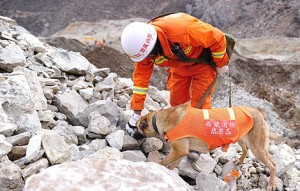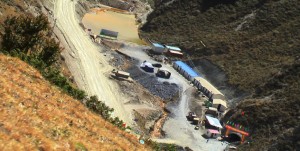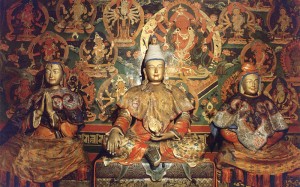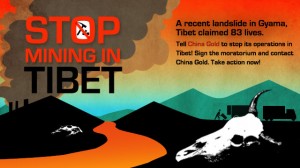On March 29, Chinese state media reported that 83 miners, including two Tibetans, were buried under a massive landslide at Gyama, 68 kilometers from Lhasa, the capital of Tibet. On April 4, it was reported that 66 bodies had been found, with 17 people reported missing, believed dead. The tragic incident took place at 6 am local time, near the mine where the miners were asleep in tents. They were buried under the mud and rock landslide which was 3 to 4 kilometers wide and 30 meters deep.
Gyama has the richest deposit of mineral resources in Tibet. Copper, chromium, gold, lead, iron, and zinc are extracted by the ton by Chinese and other foreign mining companies based in Tibet. The mining station affected by the landslide is currently owned and operated by Tibet Huatailong Mining Development Company Limited, a subsidiary of China National Gold Group.
Historically, Tibetans in the region consider Gyama to be of prime importance as the birthplace of Songtsen Gampo, one of the greatest Dharma Kings of Tibet. The valley is also home to many sacred historical temples such as Gyelpo Khangkar, a 12century monastery containing images of Songtsen Gompo and Rinchen Gong monastery which was built in the year 1181. Every year, thousands of Tibetans flock to the valley on pilgrimage. Beijing based writer and dissident Tsering Woeser brings out another dimension of the tragedy in her blog: “I mention Songtsen Gampo often, always in the hope that those greedy cadres and companies would show some mercy.” Woeser, who visited the valley in 2005 called the Gyama landslide a man-made disaster, not a natural one.
Following the landslide, the Chinese state media and Tibet Regional Propaganda Office were quick to portray the accident as a “natural disaster” without giving any specific evidence. Dorjee, an academic with the Chinese Acadamy of engineering, stated “The area from which the landslide originated was previously covered by large glaciers. Rocks hidden under the glaciers broke into smaller, loose rocks over a long period of time due to thermal expansion and contraction stress, as well as rainy and snowy weather.” He further stressed that “The smaller rocks near the source of the landslide collected together and snowballed into a massive landslide that was incredibly destructive”.
On April 5, a team of six experts led by Cen Jiafa, a researcher from the Ministry of Land and Resources in the Chinese Government, published a report of their investigation in order to justify these claims. The report states that it was a combination of the steepness of the slope, disintegrating rock and water from snowmelt which caused the landslide. The report added “The Mountain where the landslide occurred has a slope of up to 45 degrees and the drop along the 1,980 meters long landslide is 824 meters high.”
The Environment and Development Desk (EDD) of Department of Information and International Relations (Central Tibetan Administration) firmly believes that the landslide in Gyama is a man-made phenomenon, rather than a natural disaster as stated by the Chinese state Researchers. EDD agrees with the suggestion by the Chinese investigation team that the steepness of the slopes, together with disintegration of rock have been a key cause of this landslide. However they disagreed with the findings that it was the glacial dynamics that caused the landslide.
During the past year, surface mining has been carried out at the top of a prominent mountain, and an area estimated to be 420 meters long and 250 meters wide has been flattened. This is evident from Google earth images of the mining activity in Gyama over the years. It has been estimated that 1.89 million cubic meters has been removed from the mountaintop, reducing it to a flat, ridge-like structure.
These mining activities have impacted on the lives of Tibetans living in the region. Since 2011, nearly one and a half million nomads are reported to have been resettled in cities, with forceful confiscation of ancestral agricultural lands. Mine tailings and chemical effluents are dumped in local rivers causing pollution. The EDD have called for these activities to stop, and for priority to be given to the needs of the Tibetan people and communities.








 Print
Print Email
Email